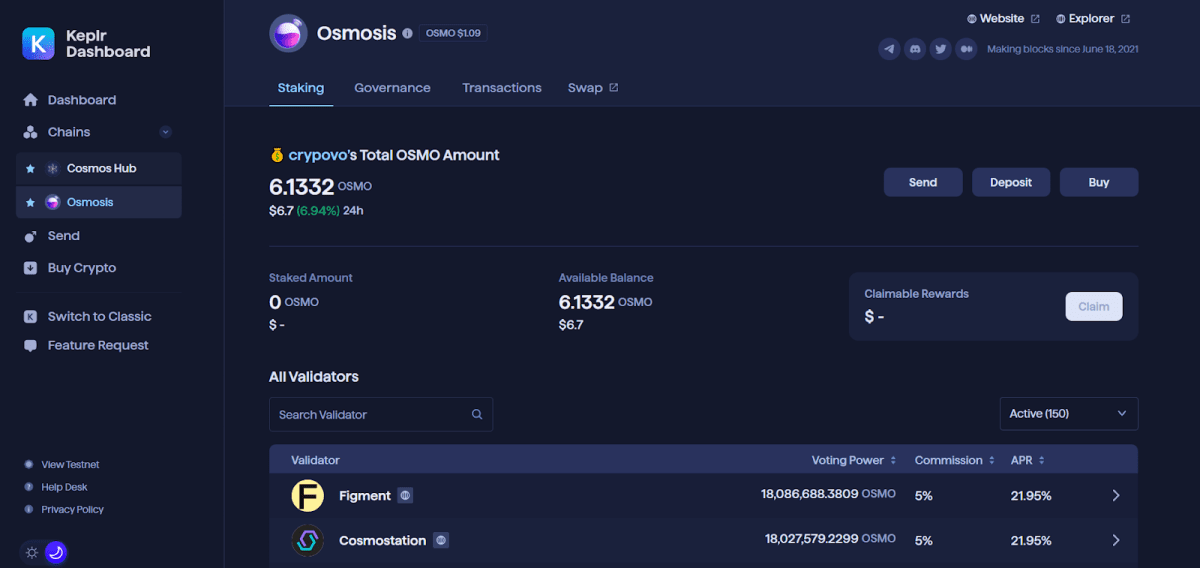Osmosis: the largest DEX in the Cosmos ecosystem

Osmosis is the biggest decentralized exchange in the Cosmos ecosystem in terms of trading volume and active user count.
Osmosis, like Polkadot's parachains, functions beyond its role as a decentralized exchange. As a separate blockchain, it is also compatible with Cosmos Hub and maintains its own ecosystem and cryptocurrency.
To use the platform, you need to have its native token, OSMO, in your wallet to pay the fees. We've developed a detailed guide on how to use the Osmosis platform.
Statistics
While CoinGecko ranks Osmosis as the 20th largest DEX exchange with an average daily trading volume of $20 million. CoinMarketCap reports a slightly lower volume, while the analytical resource DeFiLama shows a volume of $21 million, placing it 17th among all DEX platforms.
Osmosis itself provides similar statistics. The platform sees a daily trading volume of $20.5 million, and the total volume of locked liquidity exceeds $200 million. OSMO, ATOM and USDC are the most frequently traded coins by users.

Osmosis' trade statistics
You can also check out liquidity statistics for different cryptocurrency pairs, individual tokens, and recent user transactions in the Stats tab.
How it works
Osmosis functions similarly to other DEXs, but with the added bonus that you can trade any cryptocurrency that's part of the Cosmos Hub ecosystem. Essentially, Evmos, Cronos or Mars are separate blockchains, but they can easily sync and interact with each other due to their shared architecture.
To start trading on Osmosis, you'll need to install a browser wallet like Keplr, which is a Google Chrome extension that easily connects to dApps.
Once you have Keplr set up, you'll need to deposit funds into Osmosis by sending ATOM or OSMO coins from a cryptocurrency exchange to Keplr, and then transferring the tokens from the wallet to the DEX. You can do this in the Assets section of the platform.

The Assets tab for transferring tokens between the DEX and the wallet
In fact, there is no need to top up your Osmosis wallet from the exchange, as the platform has a built-in fiat gateway for buying crypto with a credit card or bank transfer.
The home page has a Swap tab for exchanging tokens. Transaction fees are charged in OSMO coins. The average swap fee is $0.01.

Swap tab for exchanging tokens
Profit tools
Osmosis offers various ways to generate income, including yield farming. To do this, you just need to add your coins to the liquidity of a trading pair and you'll start receiving a portion of the trading fees and rewards from the platform. You can find this feature in the Pools section.
Some of the trading pairs (wAVAX/OSMO, WLD/OSMO) offer profits of up to 80%. The most popular pairs are ATOM/OSMO (14% ROI), USDC/OSMO (15.2% ROI), ETH/OSMO (23.8% ROI). BTC, DAI, EVMOS, CRO and many other coins are also available for yield farming.

Pools tab: yield farming on Osmosis
You can also stake your OSMO and ATOM coins by delegating them to the official validator in the Stake section. ATOM provides a total return of 21%, with OSMO offering a slightly higher rate of up to 24% p.a.

OSMO and ATOM coin stacking tab
OSMO cryptocurrency
OSMO is an internal token used for paying fees, staking, and participating in platform governance as part of the DAO. Below you'll find vital insights into the coin:
- market cap – $575 million;
- max supply – 1,000,000,000;
- circulating supply – 527,657,515;
- average daily trading volume – $30 mln;
- All-time high – $11.14;
- All-time low – $0.68.
The cryptocurrency can be traded on the Gate, Mexc, KuCoin, and DEX Osmosis.

OSMO token exchange rate fluctuations
DAO and Osmosis ecosystem
In the Vote section, users can suggest changes to the platform's development vector as well as give their vote for new integrations. Essentially, they have a say in managing the decentralized exchange (DEX). The significance of each DAO participant depends on the number of OSMO coins they hold in their wallet.

Osmosis governance by DAO
The Osmosis ecosystem evolves alongside the main Cosmos Hub blockchain. Users can already utilize various cryptocurrency wallets, credit protocols, cross-chain bridges, NFT marketplaces, and other applications that enhance the credibility and overall liquidity of Osmosis.
Recommended

